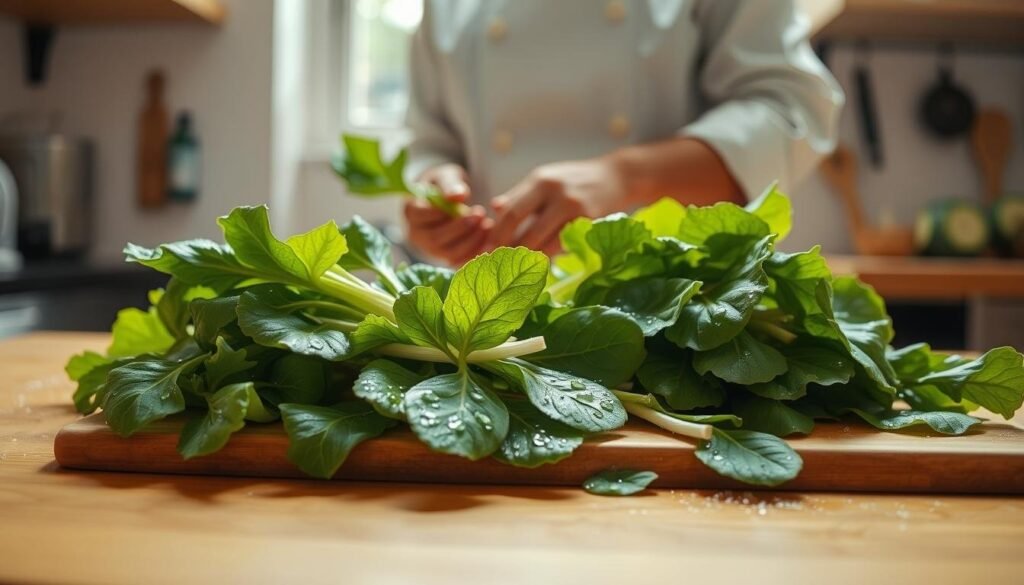Discover If Radish Leaves Are Safe: Radish greens have been a staple in many cuisines for centuries. They are especially popular in Asian and Mediterranean cooking. These greens add a unique flavor and texture to various dishes.
Radish leaves edible and full of nutrients. They are a great addition to your diet. In this article, we’ll look at their nutritional value and how to use them in your meals.
Radish greens can make your cooking better. They are a versatile ingredient. You can use them in salads, sautés, and more.
Contents
- 1 Are Radish Leaves Edible?
- 2 Can You Eat the Leaves of Radishes? The Definitive Answer
- 3 Nutritional Benefits at a Glance
- 4 Nutritional Profile of Radish Leaves
- 5 How to Prepare and Cook Radish Leaves
- 6 Comparing Radish Leaves to Other Edible Greens
- 7 Embracing the Nutritional Power of Radish Leaves
- 8 FAQ: Discover If Radish Leaves Are Safe
Are Radish Leaves Edible?
Radish leaves are not only safe to eat but also full of nutrients. They are a great addition to your diet because of their vitamins and minerals. So, yes, radish leaves are definitely edible.
You can eat radish leaves raw or cooked, whichever you like. Raw leaves add a peppery taste to salads, similar to radish roots. Cooking them can make them less spicy and more enjoyable for some.
Before eating radish leaves, make sure to wash them well. This removes dirt and any pesticides. Here’s how radish leaves compare to other leafy greens in terms of nutrition:
| Leafy Green | Vitamin A | Vitamin C | Calcium |
|---|---|---|---|
| Radish Leaves | High | High | Moderate |
| Spinach | High | Moderate | High |
| Kale | High | High | High |
Radish leaves are a nutritious choice, offering a good mix of vitamins and minerals. Adding them to your meals can bring health benefits and variety to your diet.
Can You Eat the Leaves of Radishes? The Definitive Answer
Wondering if radish leaves are safe to eat? The answer is yes. They are not only edible but also packed with nutrients. Radish leaves are rich in vitamins A, C, and K, and minerals like potassium and calcium.
Eating radish greens offers health benefits. Their antioxidants protect cells from damage. Make sure to pick fresh leaves without signs of wilting or yellowing.
Young radish leaves are less bitter and tender. They’re perfect for salads. Adding radish leaves to your diet brings a unique flavor and nutritional value.
Nutritional Benefits at a Glance
| Nutrient | Benefit | Amount per Serving |
|---|---|---|
| Vitamin A | Supports eye health | 20% DV |
| Vitamin C | Boosts immune system | 30% DV |
| Calcium | Supports bone health | 10% DV |
Adding radish leaves to your meals boosts your nutrient intake. They make your diet healthier and more delicious.
Nutritional Profile of Radish Leaves
Radish greens are more than just food; they’re a powerhouse of nutrition. Adding them to your diet boosts your nutrient intake. They are packed with vitamins A and C, which are key for a strong immune system and good eye health.
Vitamin K in radish leaves is great for bones and blood clotting. They also have dietary fiber, which helps with digestion and keeps you full. Plus, they contain antioxidants and phytochemicals that fight inflammation and may prevent chronic diseases.
When you add radish leaves to your meals, remember they’re low in calories but high in nutrients. This makes them perfect for a healthy diet. Radish leaves offer a wealth of vitamins and minerals that boost your overall health.
It’s easy to include radish greens in your meals. You can toss them in salads, sauté them as a side, or blend them into smoothies. Their versatility makes it simple to enjoy their nutritional benefits.
How to Prepare and Cook Radish Leaves
Preparing radish leaves is easy and can make your dishes better. You can use them in many ways, like in salads or soups.

You can add radish leaves raw to salads for a peppery taste, like arugula. Just wash them, chop them up, and mix with your favorite salad ingredients.
Sautéing and Stir-Frying
Another great way to enjoy radish leaves is by sautéing or stir-frying them. Heat some olive oil, add garlic or shallots for flavor, and then add the chopped leaves. They cook fast, so watch the heat to avoid burning.
Adding to Soups and Stews
Radish leaves are also good in soups and stews. Add them towards the end of cooking. This way, their flavors mix well with the other ingredients, making a nutritious meal.
Try different cooking methods to find your favorite way to eat radish leaves. They’re great raw, sautéed, or in a stew. Radish leaves can make many dishes better.
- Use radish leaves in salads for a fresh twist.
- Sauté them with garlic as a side dish.
- Add them to soups and stews for extra nutrition.
Comparing Radish Leaves to Other Edible Greens
Radish leaves are a hidden gem among leafy greens. They offer a distinct taste and many health benefits. Unlike spinach or kale, radish leaves have a peppery taste. This can add a delightful twist to your meals.
They also contain unique phytochemicals. These may offer additional health benefits.
When choosing greens, think about nutritional content and flavor. Radish leaves are great in salads or sautéed mixes. They provide a contrast to milder greens like lettuce or collard greens.
Here’s a comparison of the nutritional profiles of radish leaves with other popular edible greens:
| Leafy Green | Calories per Cup | Vitamin K Content | Vitamin A Content |
|---|---|---|---|
| Radish Leaves | 20 | High | Moderate |
| Spinach | 7 | High | High |
| Kale | 55 | High | High |
| Lettuce | 10 | Low | Low |
You can add radish leaves to your diet in many ways. Try them in salads, sautéed with garlic, or in smoothies. This can help you discover new flavors and boost your meal’s nutrition.
By adding radish leaves to your meals, you get to enjoy their unique taste. You also get their health benefits. This makes them a valuable part of your diet.
Embracing the Nutritional Power of Radish Leaves
Radish leaves are packed with nutrients and can make any dish better. They add health benefits to your meals. Eating them can boost your health with antioxidants, vitamins, and minerals.
Radish greens are great for a healthy diet. You can use them raw or cooked in salads, sautés, and more. They bring a special flavor and texture to your food.
So, next time you’re cooking radishes, don’t forget the leaves. They’re nutritious and can make your diet even better.
See Also: Can You Eat Cauliflower Leaves?
FAQ: Discover If Radish Leaves Are Safe
Are radish leaves safe to eat?
Yes, radish leaves are safe to eat. They are packed with vitamins A, C, and K. They also have minerals like potassium and calcium.
How can I prepare radish leaves for consumption?
You can eat radish leaves raw or cooked. For raw, wash and chop them, then add to salads. For cooked, sauté with garlic or shallots, or add to soups and stews.
What are the nutritional benefits of radish leaves?
Radish leaves are full of vitamins A and C, vitamin K, and dietary fiber. They also have antioxidants and phytochemicals. These make them great for a healthy diet, supporting your immune system, eye health, bone health, and digestion.
How do radish leaves compare to other edible greens?
Radish leaves have a unique peppery flavor. They have different phytochemicals than spinach or kale. This makes them a great choice for a diverse salad or sautéed mix.
Can I eat young radish leaves raw?
Yes, young radish leaves are less bitter and more tender. They are perfect for raw use in salads or as a garnish.
How do I ensure radish leaves are safe to eat?
To make sure radish leaves are safe, wash them well before eating. This removes dirt and potential pesticides. Choose fresh leaves that are not wilted or yellow.

Hello, I am Bellamy George, a certified nutritionist and food safety specialist from Springfield, IL. With a degree in Food Science, I share research-backed insights on edible foods, seeds, and seafood for safe, informed eating.

